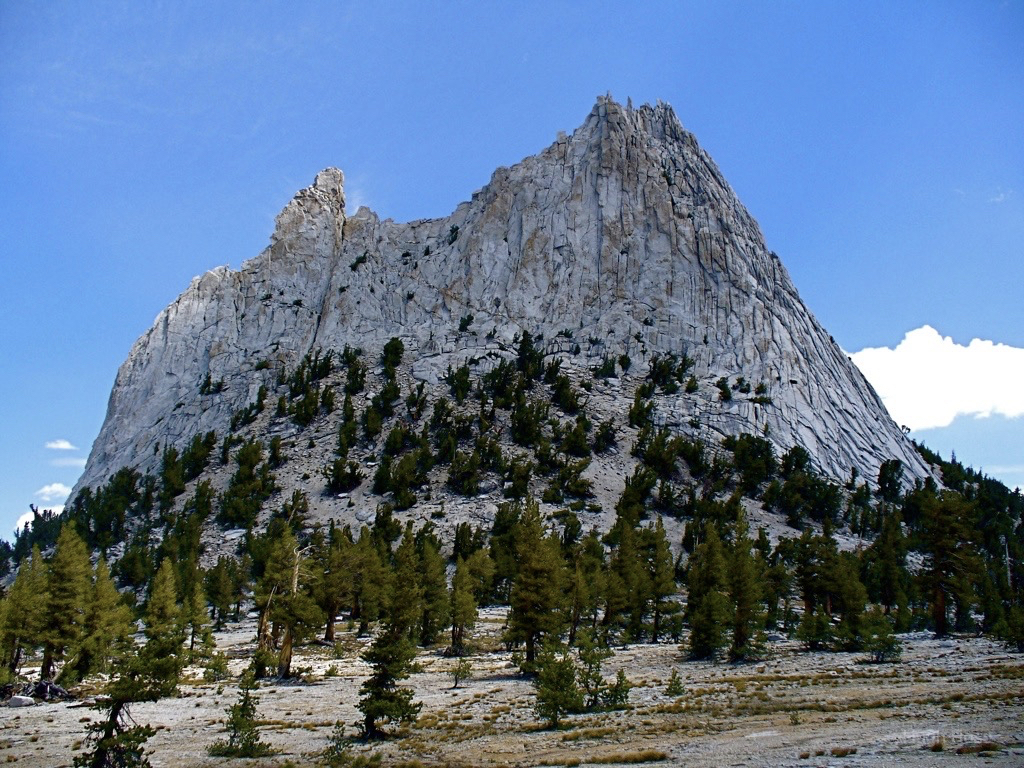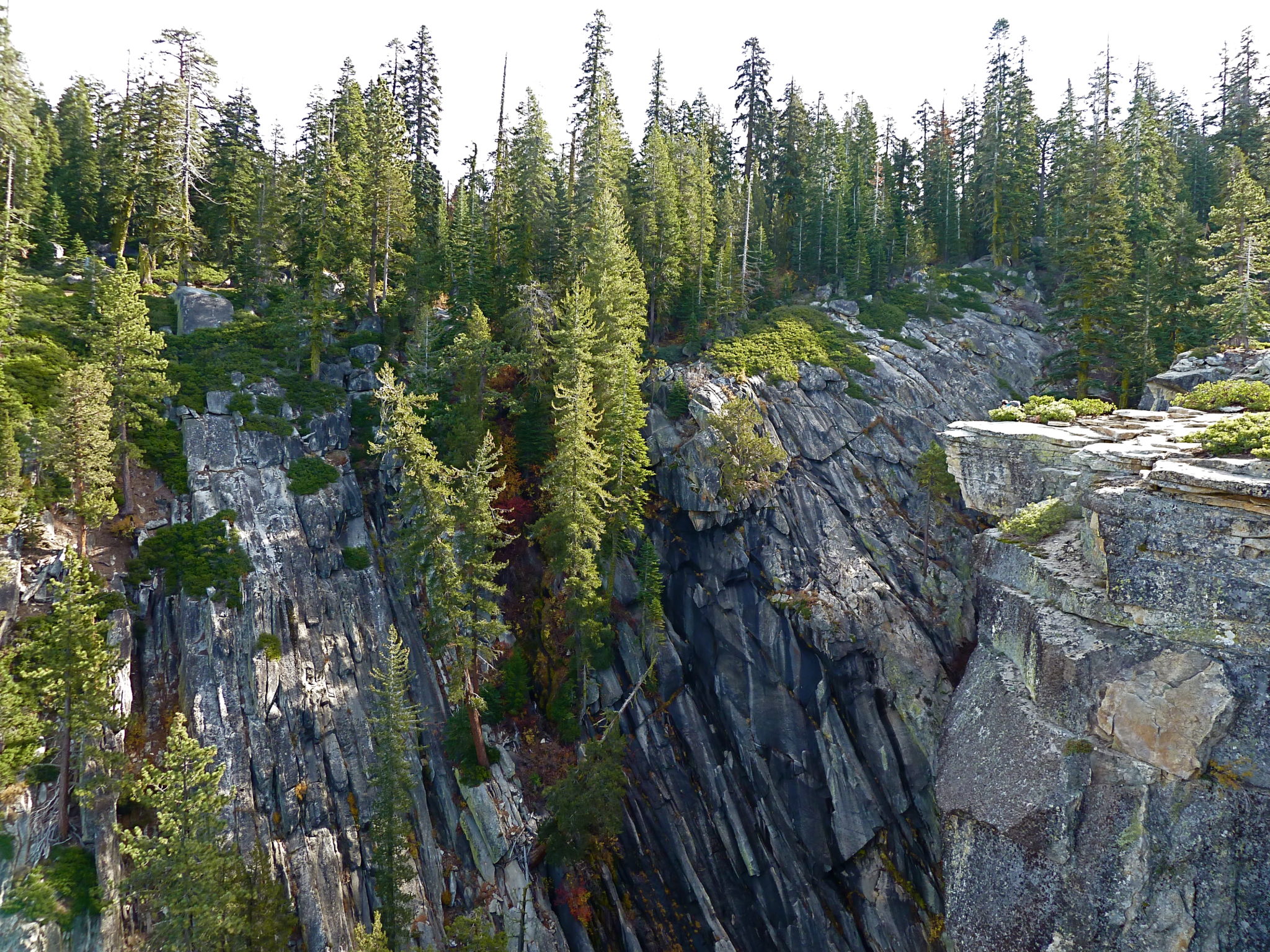Design Implications of Bedrock Water and Woody Plants
We’ve all seen a tree growing out of a rock (see figure) and perhaps wondered how it got water. Scientists have discovered that such trees not only get plenty of water and minerals but also create water reservoirs in bedrock.
Bedrock Stores Water
Most people assume terrestrial plants get all their water and mineral nutrients from soil. It seems obvious that when soil dries out, plants shrivel, and in extreme drought conditions, they die.
However, woody plants (shrubs and trees) are able to access another source of water and minerals. Several field studies reveal that woody plants can tap into substantial quantities of water and mineral nutrients from bedrock lying below the soil layer.1
Bedrock is relict primary rock that manifests distinct hydraulic processes.2 Water and minerals can reside in pores, fractures, and hydrated minerals in the bedrock.
Quantities of Root-Zone Bedrock Water Storage
A team of seven geologists led by Erica McCormick, University of Texas at Austin, first quantified the amount of water stored in the root zone of bedrock throughout the 48 contiguous United States (CONUS).3 Based on the maximum observed depth of tree root penetration of bedrock,4 McCormick’s team determined that the bedrock root zone lies in the upper 6 meters of bedrock.
The team also noted that a large fraction of CONUS bedrock lies less than 1.5 meters below the surface. And for over 45% of the wooded land area over the CONUS, bedrock is less than 1.5 meters below the surface.
Bedrock Water Transpiration
One way to determine the degree to which woody plants access and use bedrock water is to measure the volumes of bedrock water transpiration. Transpiration refers to the exhalation of water vapor to the atmosphere through the stomata in the epidermis of plant leaves, needles, and stems. Plants lose 95–99% of the water they access from the ground through transpiration.
The geologists demonstrated that throughout the CONUS, woody plants extensively access bedrock water for transpiration. Regardless of their climate zones, these woody plants draw bedrock water routinely, not just under drought conditions.
McCormick and her colleagues did their most in-depth measurements and analysis on the shrub and forest regions of California and Texas. They determined that trees and shrubs that access a large fraction of their water from bedrock account for over 50% of California’s aboveground carbon stocks (see figure).

Figure: Trees on Cathedral Peak in California Get Nearly All Their Water from Bedrock Sources
Credit: Hugh Ross
To support its population of 40 million and the nation’s most intensive agricultural enterprise, California has constructed a vast system of water reservoirs. These reservoirs store about 16 million acre-feet of water.5 The research study by McCormick’s team showed that on an annual basis the volume of bedrock water transpiration in California exceeds all the water stored in California’s reservoirs.
This study was limited to the CONUS. However, the researchers cite several other studies that document how bedrock water use by woody planets in the CONUS is an excellent proxy for the same process elsewhere in the world.6
Design Implications
Based on the team’s research, bedrock moisture constitutes a critical component of Earth’s water and carbon cycles, both of which must be fine-tuned for life to exist and thrive. Huge volumes of water are stored in bedrock throughout the world. Woody plants harvest much of this water and transfer almost all of it to the atmosphere through transpiration. This transpired water plays a crucial role in sustaining the water cycle. Without transpired bedrock water, there would not be enough precipitation of rain and snow on Earth’s landmasses to support either the flora or the fauna to make the existence of humans possible.
As the roots of shrubs and trees penetrate the cracks and crevasses in bedrock to harvest water, they increase the sizes of these cracks and crevasses and create many more. This bedrock crack and crevasse enhancement enlarges the volume of water that can be stored in bedrock. This larger volume of bedrock water makes a greater biomass of woody plants possible. In turn, the greater woody plant biomass increases precipitation over Earth’s landmasses, supports a more diverse and abundant ecosystem of plants and animals, and enhances the global human economy.
Shrub and tree roots penetrating bedrock cracks and crevasses also expose more of the bedrock to water. Liquid water, as it contacts bedrock surfaces, acts as a catalyst to drive the silicate weathering of bedrock. Silicate weathering removes carbon dioxide, a powerful greenhouse gas, from the atmosphere.7 Due to this reduction in atmospheric carbon dioxide, while the Sun progressively brightens as it continues to fuse hydrogen into helium, Earth’s atmosphere becomes progressively weaker in its capacity to trap the Sun’s increasing heat. Consequently, thanks to trees and shrubs efficiently harvesting bedrock water, the global mean temperature of Earth’s surface remains optimal for life.
If trees and shrubs did not exist that could efficiently harvest bedrock water and minerals:
1. Human life would be physically impossible.
2. Earth would have become sterile hundreds of millions of years ago.
3. There would be much fewer biodeposits and of much lower quality.
4. Earth would be less beautiful.
5. There would be no natural shade.
This geological research provides yet another scientific example that affirms an important biblical principle: the more we learn about our planet and its life, the more evidence we accrue for the supernatural handiwork of God and his exquisite designs that make it possible for humans to thrive and fulfill our purpose and destiny.
Endnotes
- Susanne Schwinning, “The Ecohydrology of Roots in Rocks,” Ecohydrology 3, no. 2 (June 2010): 239–245, doi:10.1002/eco.134; Susanne Schwinning, “A Critical Question for the Critical Zone: How Do Plants Use Rock Water?” Plant and Soil 454 (September 2020): 49–56, doi:10.1007/s11104-020-04648-4; M. A. Bornyasz, R. C. Graham, and M. F. Allen, “Ectomycorrhizae in a Soil-Weathered Granitic Bedrock Regolith: Linking Matrix Resources to Plants,” Geoderma 126, nos. 1–2 (May 2005): 142–160, doi:10.1016/j.geoderma.2004.11.023.
- John R. Nimmo et al., “Preferential Flow, Diffuse Flow, and Perching in an Interbedded Fractured-Rock Unsaturated Zone,” Hydrogeology Journal 25, no. 2 (March 2017): 421–444, doi:10.1007/s10040-016-1496-6.
- Erica L. McCormick et al., “Widespread Woody Plant Use of Water Stored in Bedrock,” Nature 597, no. 7875 (September 9, 2021): 225–229, doi:10.1038/s41586-021-03761-3.
- David Uhlig et al., “Quantifying Nutrient Uptake as Driver of Rock Weathering in Forest Ecosystems by Magnesium Stable Isotopes,” Biogeosciences 14, no. 12 (June 26, 2017): 3111–3128, doi:10.5194/bg-14-3111-2017.
- “Daily Reservoir Storage Summary,” California Department of Water Resources, California Data Exchange Center, accessed September 13, 2021.
- T. S. David et al., “Constraints on Transpiration from an Evergreen Oak Tree in Southern Portugal,” Agricultural and Forest Meteorology 122, nos. 3–4 (April 20, 2004): 193–205, doi:10.1016/j.agrformet.2003.09.014; José Ignacio Querejeta et al., “Water Source Partitioning among Trees Growing on Shallow Karst Soils in a Seasonally Dry Tropical Climate,” Oecologia 152 (May 2007): 26–36, doi:101007/s00442-006-0629-3; Laurent Ruiz et al., “Water Balance Modeling in a Tropical Watershed under Deciduous Forest (Mule Hole, India): Regolith Matric Storage Buffers the Groundwater Recharge Process,” Journal of Hydrology 380, nos. 3–4 (January 30, 2010): 460–472, doi:10.1016/j.hydrol.2009.11.020.
- Hugh Ross, “Weathered Bedrock: Key to Advanced Life on Earth,” Today’s New Reason to Believe (blog), May 7, 2018.






